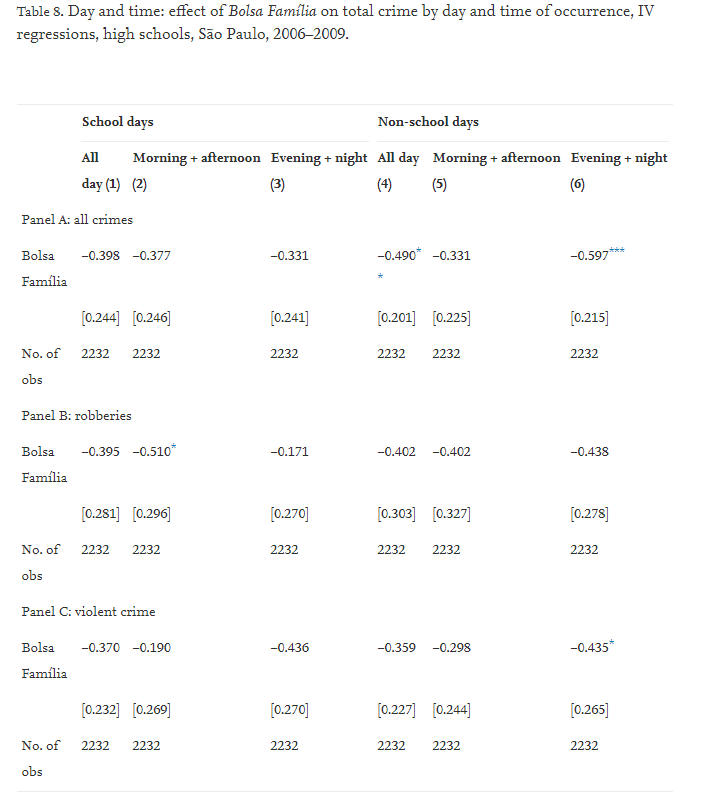Algselt postitas LaRaBla
Vaata postitust
Eeldatav Kasu: (1-t)K(S)+tK(-V)<>K(Palk)
Ehk siis kriminaal võrdleb oma kasu kui paneb kuriteo toime (1-t)K(S) ja oma kahju kui jääb vahele tK(-V) oma legaalse palga vastu K(Palk).
Kui legaalne palk on suurem, kui eeldatav kasu kuritegevusest, siis kuritegu toime ei pane. Eeldan, et kui miljonid inimesed vaesusest välja tuua, nii et nad ei peaks muretsema kust järgmine toidukord tuleb, siis nende otsus kas panna kuritegu toime või mitte on märksa lihtsam?
Toon näiteks Lula policy Bolsa Familia. Uurimistöö näitab, et sotsiaalprogrammil mis aitab vaeseid peresid (tingimusel, et lapsed koolis käiks) on statistiliselt oluline korrelatsioon kuritegevuse kahanemisel.
This paper combines detailed crime data from the city of São Paulo with information on Bolsa Família coverage per school to provide one of the first pieces of evidence on the effect of CCTs on crime. We overcome the problem of endogeneity of CCT coverage by exploiting an institutional change to the Bolsa Família program that expanded coverage to older age groups. Combining the initial demographic composition of schools with the timing of institutional change, we construct an instrument that identifies an exogenous dimension of variation in the number of children covered by the CCT. This instrument allows us to show that CCT coverage in a school has a negative impact on crime in the school neighborhood. The evidence also indicates that the reduction in crime is not concentrated on school days, so it is likely that the incapacitation effect from time spent in school is not a particularly relevant mechanism.
Our paper speaks directly to the literature on the impact of CCTs by showing that the reductions in poverty and inequality associated with these programs have broader social consequences, which should be taken into account in program design and evaluation. Narrow impact evaluations of these interventions, focused on very specific dimensions, should therefore be taken with a grain of salt. The results also contribute to the literature on determinants of crime, by presenting an additional piece of evidence on the relationship between socioeconomic conditions and crime: Bolsa Família has been heralded as an effective and low cost instrument to fight inequality; our results suggest that the reduction in inequality determined by the program was accompanied by reduced crime rates, reinforcing the connection between inequality and crime stressed before in the literature.
Juhul kui artiklile ligi ei pääse, siis viskan paar tabelit:
In order to understand the channels through which Bolsa Família affects crime, we estimate our benchmark specification for different types of crime, for days with and without classes, and for different hours of the day.
Our instrument makes use of the number of students between 16 and 17 in 2006 and one may think that changes in the number of students in this age group are directly related to crime. The literature on the demographic determinants of crime, such as Levitt (1999) and Jacobson (2004), would indeed raise this concern. So we control for the log of the number of students between ages 16 and 17 in each year in all specifications. We also control for the log of the total number of students in the school, since students at other age groups are both potential offenders and victims. Furthermore, given that children from different schools interact and migrate across boundaries of school districts, in some specifications we control for the log of the number of children in neighboring schools. To construct this variable, we count the number of students enrolled in schools within 2 km of a given school. Finally, we control for various characteristics of teachers, students, and schools, all of which are likely to be correlated with local socioeconomic conditions. Our full set of controls includes the following: number of students between ages 16 and 17 (log), number of students (log), average years of schooling of teachers (log), teacher-student ratio (log), students per classroom (log), a dummy for access to sanitation in the school, percentage of non-white students, percentage of delayed students, a dummy for the availability of computers for students, the proportion of high school students in the school, and, in some specifications, number of students enrolled in schools within 2 km (log). These are intended to capture, above all, socioeconomic conditions associated with the area where the school is located (or, similarly, of the students’ families) and impacts of other competing policies that may have similar effects to those expected from CCTs.




Kommentaar